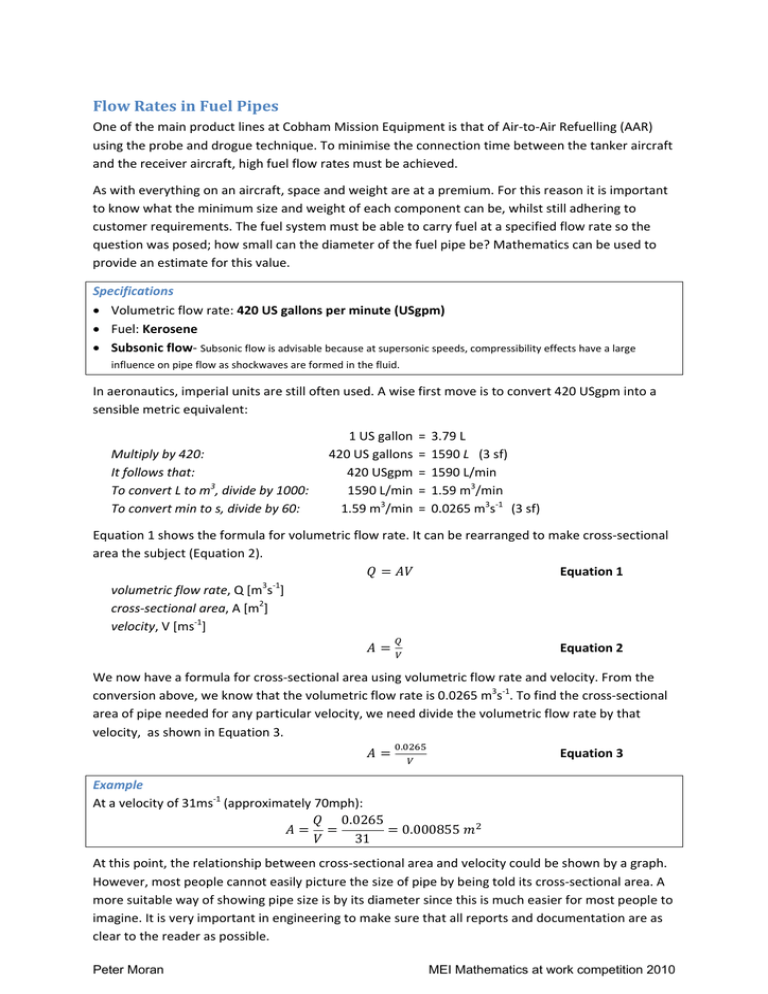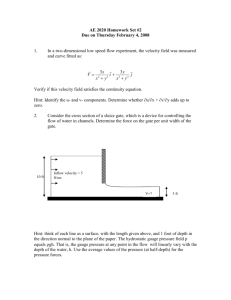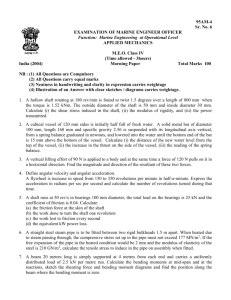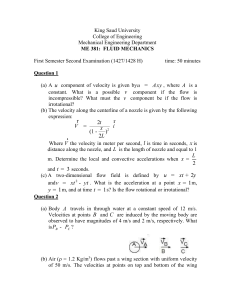Flow Rates in Fuel Pipes
advertisement

Flow Rates in Fuel Pipes One of the main product lines at Cobham Mission Equipment is that of Air‐to‐Air Refuelling (AAR) using the probe and drogue technique. To minimise the connection time between the tanker aircraft and the receiver aircraft, high fuel flow rates must be achieved. As with everything on an aircraft, space and weight are at a premium. For this reason it is important to know what the minimum size and weight of each component can be, whilst still adhering to customer requirements. The fuel system must be able to carry fuel at a specified flow rate so the question was posed; how small can the diameter of the fuel pipe be? Mathematics can be used to provide an estimate for this value. Specifications • Volumetric flow rate: 420 US gallons per minute (USgpm) • Fuel: Kerosene • Subsonic flow‐ Subsonic flow is advisable because at supersonic speeds, compressibility effects have a large influence on pipe flow as shockwaves are formed in the fluid. In aeronautics, imperial units are still often used. A wise first move is to convert 420 USgpm into a sensible metric equivalent: Multiply by 420: It follows that: To convert L to m3, divide by 1000: To convert min to s, divide by 60: 1 US gallon = 3.79 L 420 US gallons = 1590 L (3 sf) 420 USgpm = 1590 L/min 1590 L/min = 1.59 m3/min 1.59 m3/min = 0.0265 m3s‐1 (3 sf) Equation 1 shows the formula for volumetric flow rate. It can be rearranged to make cross‐sectional area the subject (Equation 2). Equation 1 volumetric flow rate, Q [m3s‐1] cross‐sectional area, A [m2] velocity, V [ms‐1] Equation 2 We now have a formula for cross‐sectional area using volumetric flow rate and velocity. From the conversion above, we know that the volumetric flow rate is 0.0265 m3s‐1. To find the cross‐sectional area of pipe needed for any particular velocity, we need divide the volumetric flow rate by that velocity, as shown in Equation 3. . Equation 3 Example At a velocity of 31ms‐1 (approximately 70mph): 0.0265 31 0.000855 At this point, the relationship between cross‐sectional area and velocity could be shown by a graph. However, most people cannot easily picture the size of pipe by being told its cross‐sectional area. A more suitable way of showing pipe size is by its diameter since this is much easier for most people to imagine. It is very important in engineering to make sure that all reports and documentation are as clear to the reader as possible. Peter Moran MEI Mathematics at work competition 2010 To convert area to diameter, we can take the well known equation for the area of a circle (Equation 4). Equation 4 We know that the radius is half the diameter so we replace with to give Equation 5: Equation 5 We now have an equation for area using the diameter instead of the radius. To make the diameter the subject, follow Equation 6: 2 Equation 6 Example Using Equation 6 and the answer from the previous example: 2 2 . 0.0330 (3 sf) This, if multiplied by 1000, converts to 33.0 . This means that at a velocity of 31ms‐1, to achieve a flow rate of 420USgpm, a pipe must have a diameter of 33.0mm. These calculations can be used for a range of velocities. The specification for the velocity is that it must be subsonic, meaning less than the speed of sound. Although the speed of sound in air is around 340ms‐1, the fluid we are looking at is Kerosene fuel. The speed of sound in Kerosene is 1324ms‐1 so a range of velocities of 5‐1324 ms‐1 could be plotted on a graph against pipe diameter. 90.0 80.0 70.0 Pipe Diamter [mm] 60.0 50.0 40.0 30.0 20.0 10.0 0.0 0 200 400 600 800 Velocity [ms‐1] 1000 1200 1400 From this graph it can be seen that a pipe with a diameter of greater than around 5mm would, in theory, be capable of carrying 420 USgpm of Kerosene at subsonic velocities. Peter Moran MEI Mathematics at work competition 2010







